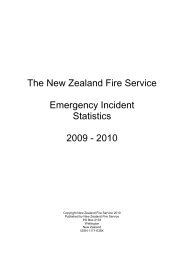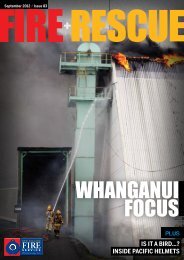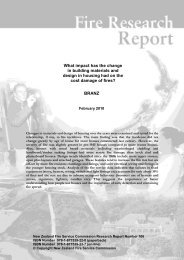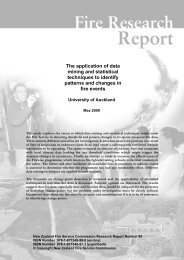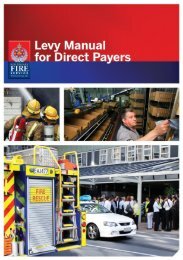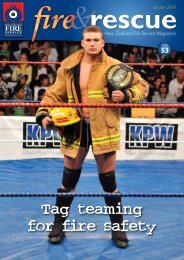Download - New Zealand Fire Service
Download - New Zealand Fire Service
Download - New Zealand Fire Service
You also want an ePaper? Increase the reach of your titles
YUMPU automatically turns print PDFs into web optimized ePapers that Google loves.
Moving to long-life<br />
smoke alarms<br />
Long-life photoelectric smoke alarms are now the alarm of choice for the <strong>Fire</strong> <strong>Service</strong> and<br />
will be the only alarms we buy and install in homes once supplies of the standard alarms<br />
have been used up.<br />
The long-life alarms have some huge<br />
advantages. They have a minimum<br />
10 years of life and a sealed battery<br />
compartment so the battery can’t be<br />
removed. They also eliminate the<br />
danger, particularly for elderly<br />
people, of climbing ladders to replace<br />
the batteries. Over the lifetime of the<br />
alarm, it will effectively pay for itself<br />
as owners don’t need to buy replacement<br />
batteries once or twice a year.<br />
National Director of <strong>Fire</strong> Risk<br />
Management, Paula Beever, says,<br />
“We have been able to switch to<br />
long-life photoelectric alarms as<br />
a result of negotiating a very competitive<br />
contract with the supplier.<br />
We will be installing one alarm in<br />
Brooklyn Senior<br />
<strong>Fire</strong>fighters Joel Fraser<br />
(left) and Jason Courtis<br />
check out the new<br />
long-life smoke alarms.<br />
the exit path of each level of the home<br />
and staff are asked to encourage<br />
people to install other long-life or<br />
standard photoelectric alarms as<br />
soon as practicable.<br />
“The message is that we want to<br />
provide a ‘hand up’ to people who<br />
are most at risk of a fire, not provide<br />
a ‘hand out’. We want to help them<br />
understand the dangers of fire so<br />
they can take responsibility for<br />
protecting their families.”<br />
We recommend that people install<br />
photoelectric alarms in every bedroom,<br />
hallway, and living area on<br />
every level of the house. However, we<br />
recognise this is not always practical<br />
or realistic so our advice to the<br />
<strong>Fire</strong> Safety<br />
general public is that at an absolute<br />
minimum, they should install a longlife<br />
photoelectric alarm in the exit<br />
path closest to the bedrooms and add<br />
more as soon as they can, she said.<br />
Staff and volunteers are also<br />
encouraged to promote the installation<br />
of long-life photoelectric<br />
smoke alarms in their community<br />
whenever they have the opportunity.<br />
Our national supplier is <strong>New</strong>field<br />
Marketing and orders are taken via<br />
email through sales@newfield.co.nz<br />
Further information on the policy<br />
can be found in <strong>Fire</strong> Risk Management<br />
Bulletins 2 and 5 on the Intranet<br />
using the Search function.<br />
The <strong>New</strong> <strong>Zealand</strong> <strong>Fire</strong> <strong>Service</strong> Magazine July 2010<br />
7





